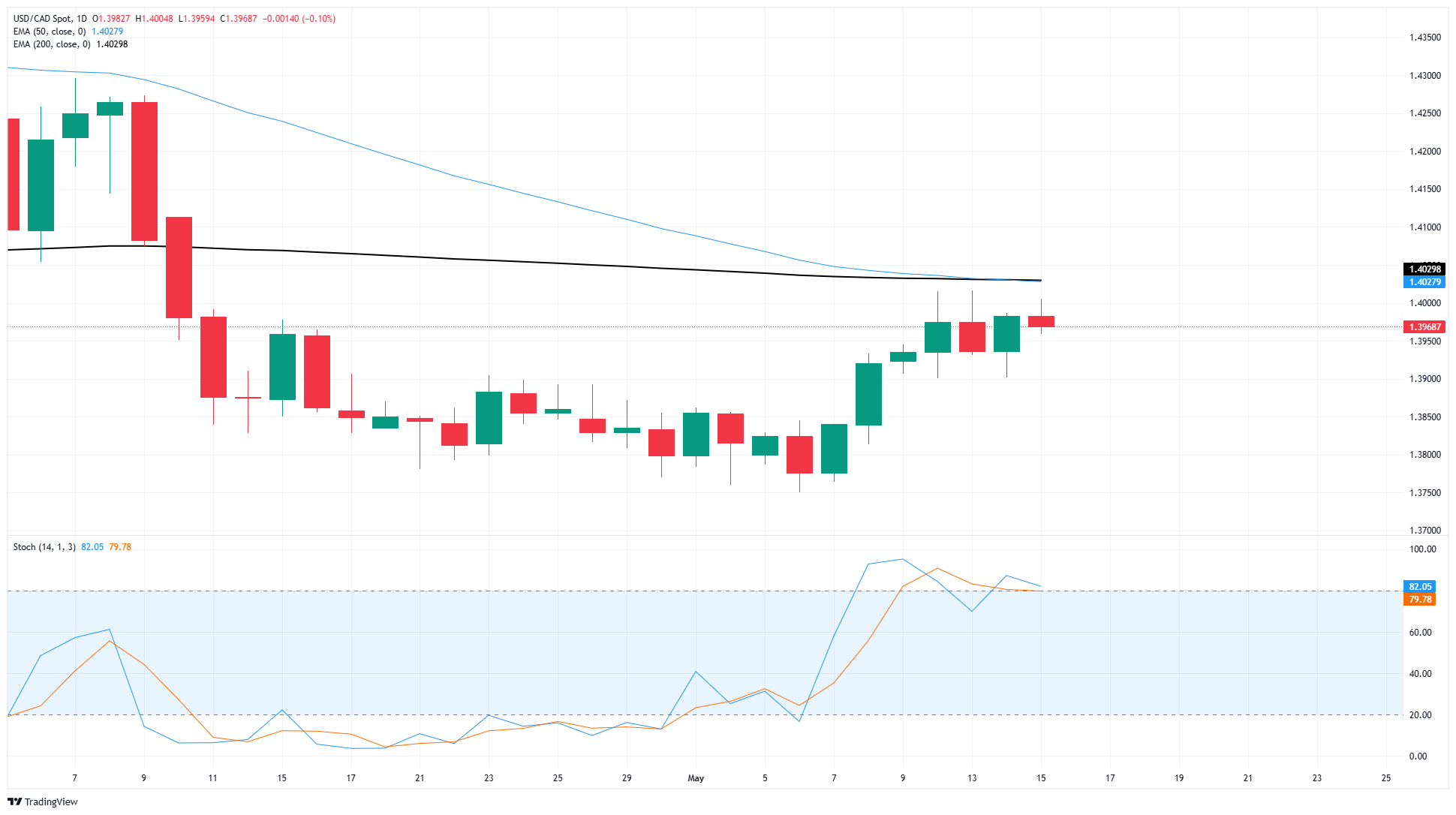Canadian Dollar middles as Loonie flows get pulled in both directions
- The Canadian Dollar remained flat against the Greenback on Thursday.
- Loonie markets remain hamstrung as USD weakness clashes with lower Crude Oil prices.
- Key US consumer sentiment data just around the bend, Canadian data forced to wait until next week.
The Canadian Dollar (CAD) went nowhere fast on Thursday, with the Loonie struggling to find momentum on either side. The US Dollar (USD) was softly lower on the day, however another decline in intraday Crude Oil prices pulled the support rug out from underneath the CAD, keeping the USD/CAD major pair strung along a familiar congestion level just south of 1.4000.
Key Canadian economic data lies ahead next week, but Loonie markets will first need to survive a fresh print in US consumer sentiment figures from the University of Michigan (UoM) on Friday, as well as an extended weekend with Canadian markets shuttered for the Victoria Day holiday next Monday. Loonie traders will return to the fold on Tuesday, just in time for a fresh Consumer Price Index (CPI) inflation update.
The US Dollar is overall weaker on Thursday, which would typically be enough to force the Loonie slightly higher. However, a fresh knock lower in Crude Oil prices is stripping support away from the Canadian Dollar, keeping the Loonie lashed tightly in place against the Greenback.
Daily digest market movers: Canadian Dollar stuck in a rut on Thursday
- The Canadian Dollar remained buried in a flat holding pattern, stuck in familiar territory as the USD/CAD pair churns chart paper just below 1.4000.
- Loonie traders are heading for a long weekend, they just have to survive Friday first.
- Canadian CPI inflation figures due next Tuesday will draw plenty of CAD attention as investors wonder how much deeper the Bank of Canada (BoC) will cut interest rates.
- US Producer Price Index (PPI) inflation chilled faster than expected in April, however tariff impacts have yet to leak into headline economic data, and investors remain leery but cautiously optimistic.
- May’s UoM Consumer Sentiment Index is due on Friday, and markets are hoping that US consumers will suddenly feel better about how much they have to pay for goods originating from other countries.
Canadian Dollar price forecast
USD/CAD continues to cycle just below the 1.4000 major handle. The pair is caught in a near-term consolidation phase near the 200-day Exponential Moving Average (EMA) near 1.4030, making it difficult to time a snap in either direction.
Depending on how you view the market, a fresh bout of Loonie weakness, or Greenback strength, pushed USD/CAD up from near-term lows near 1.3750. Technical oscillators have drifted into overbought territory, flashing warning signs that the pair could be poised for a fresh bearish push. However, a downside move could be viewed as a technical correction rather than an outright change in medium-term momentum.
USD/CAD daily chart

Canadian Dollar FAQs
The key factors driving the Canadian Dollar (CAD) are the level of interest rates set by the Bank of Canada (BoC), the price of Oil, Canada’s largest export, the health of its economy, inflation and the Trade Balance, which is the difference between the value of Canada’s exports versus its imports. Other factors include market sentiment – whether investors are taking on more risky assets (risk-on) or seeking safe-havens (risk-off) – with risk-on being CAD-positive. As its largest trading partner, the health of the US economy is also a key factor influencing the Canadian Dollar.
The Bank of Canada (BoC) has a significant influence on the Canadian Dollar by setting the level of interest rates that banks can lend to one another. This influences the level of interest rates for everyone. The main goal of the BoC is to maintain inflation at 1-3% by adjusting interest rates up or down. Relatively higher interest rates tend to be positive for the CAD. The Bank of Canada can also use quantitative easing and tightening to influence credit conditions, with the former CAD-negative and the latter CAD-positive.
The price of Oil is a key factor impacting the value of the Canadian Dollar. Petroleum is Canada’s biggest export, so Oil price tends to have an immediate impact on the CAD value. Generally, if Oil price rises CAD also goes up, as aggregate demand for the currency increases. The opposite is the case if the price of Oil falls. Higher Oil prices also tend to result in a greater likelihood of a positive Trade Balance, which is also supportive of the CAD.
While inflation had always traditionally been thought of as a negative factor for a currency since it lowers the value of money, the opposite has actually been the case in modern times with the relaxation of cross-border capital controls. Higher inflation tends to lead central banks to put up interest rates which attracts more capital inflows from global investors seeking a lucrative place to keep their money. This increases demand for the local currency, which in Canada’s case is the Canadian Dollar.
Macroeconomic data releases gauge the health of the economy and can have an impact on the Canadian Dollar. Indicators such as GDP, Manufacturing and Services PMIs, employment, and consumer sentiment surveys can all influence the direction of the CAD. A strong economy is good for the Canadian Dollar. Not only does it attract more foreign investment but it may encourage the Bank of Canada to put up interest rates, leading to a stronger currency. If economic data is weak, however, the CAD is likely to fall.

